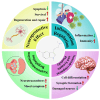Targeting 5-HT Is a Potential Therapeutic Strategy for Neurodegenerative Diseases
- PMID: 39769209
- PMCID: PMC11679250
- DOI: 10.3390/ijms252413446
Targeting 5-HT Is a Potential Therapeutic Strategy for Neurodegenerative Diseases
Abstract
There is increasing interest in the potential therapeutic role of 5-HT (serotonin) in the treatment of neurodegenerative diseases, which are characterized by the progressive degeneration and death of nerve cells. 5-HT is a vital neurotransmitter that plays a central role in regulating mood, cognition, and various physiological processes in the body. Disruptions in the 5-HT system have been linked to several neurological and psychiatric disorders, making it an attractive target for therapeutic intervention. Although the exact causes of neurodegenerative diseases such as Alzheimer's disease (AD), Parkinson's disease (PD), and amyotrophic lateral sclerosis (ALS) are not fully understood, researchers believe that regulating the 5-HT system could help alleviate symptoms and potentially slow the progression of these diseases. Here, we delve into the potential of harnessing 5-HT as a therapeutic target for the treatment of neurodegenerative diseases. It is important to note that the current clinical drugs targeting 5-HT are still limited in the treatment of these complex diseases. Therefore, further research and clinical trials are needed to evaluate the feasibility and effectiveness of its clinical application.
Keywords: 5-HT; clinical trials; neurodegenerative diseases; therapeutic target.
Conflict of interest statement
The authors declare no conflict of interest.
Figures


 ” indicates that the activation of this receptor contributes to the recovery of the symptom; “
” indicates that the activation of this receptor contributes to the recovery of the symptom; “ ” indicates that inhibition of this receptor contributes to the recovery of the symptom.
” indicates that inhibition of this receptor contributes to the recovery of the symptom.Similar articles
-
A Review of the Common Neurodegenerative Disorders: Current Therapeutic Approaches and the Potential Role of Bioactive Peptides.Curr Protein Pept Sci. 2024;25(7):507-526. doi: 10.2174/0113892037275221240327042353. Curr Protein Pept Sci. 2024. PMID: 38561605 Review.
-
Magnesium (Mg) and Neurodegeneration: A Comprehensive Overview of Studies on Mg Levels in Biological Specimens in Humans Affected Some Neurodegenerative Disorders with an Update on Therapy and Clinical Trials Supplemented with Selected Animal Studies.Int J Mol Sci. 2024 Nov 23;25(23):12595. doi: 10.3390/ijms252312595. Int J Mol Sci. 2024. PMID: 39684308 Free PMC article. Review.
-
Biochemical and therapeutic effects of antioxidants in the treatment of Alzheimer's disease, Parkinson's disease, and amyotrophic lateral sclerosis.Curr Drug Targets CNS Neurol Disord. 2003 Apr;2(2):95-107. doi: 10.2174/1568007033482959. Curr Drug Targets CNS Neurol Disord. 2003. PMID: 12769802 Review.
-
Therapeutic potential of enzymes, neurosteroids, and synthetic steroids in neurodegenerative disorders: A critical review.J Steroid Biochem Mol Biol. 2025 Jul;251:106766. doi: 10.1016/j.jsbmb.2025.106766. Epub 2025 Apr 25. J Steroid Biochem Mol Biol. 2025. PMID: 40288591 Review.
-
Conservative iron chelation for neurodegenerative diseases such as Parkinson's disease and amyotrophic lateral sclerosis.J Neural Transm (Vienna). 2020 Feb;127(2):189-203. doi: 10.1007/s00702-019-02138-1. Epub 2020 Jan 7. J Neural Transm (Vienna). 2020. PMID: 31912279 Review.
Cited by
-
Gut-brain axis and vascular dementia: a review on mechanisms and Chinese herbal medicine therapeutics.Front Microbiol. 2025 May 14;16:1564928. doi: 10.3389/fmicb.2025.1564928. eCollection 2025. Front Microbiol. 2025. PMID: 40438206 Free PMC article. Review.
-
Monoamine signaling and neuroinflammation: mechanistic connections and implications for neuropsychiatric disorders.Front Immunol. 2025 Apr 28;16:1543730. doi: 10.3389/fimmu.2025.1543730. eCollection 2025. Front Immunol. 2025. PMID: 40356905 Free PMC article. Review.
References
-
- Pentkowski N.S., Rogge-Obando K.K., Donaldson T.N., Bouquin S.J., Clark B.J. Anxiety and Alzheimer’s disease: Behavioral analysis and neural basis in rodent models of Alzheimer’s-related neuropathology. Neurosci. Biobehav. Rev. 2021;127:647–658. doi: 10.1016/j.neubiorev.2021.05.005. - DOI - PMC - PubMed
Publication types
MeSH terms
Substances
Grants and funding
LinkOut - more resources
Full Text Sources
Medical
Miscellaneous

